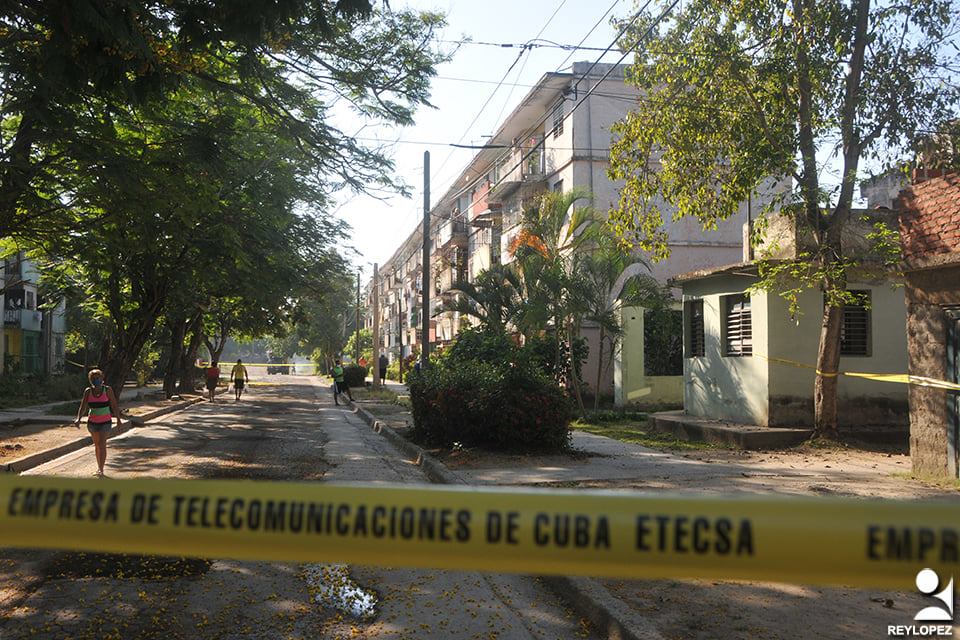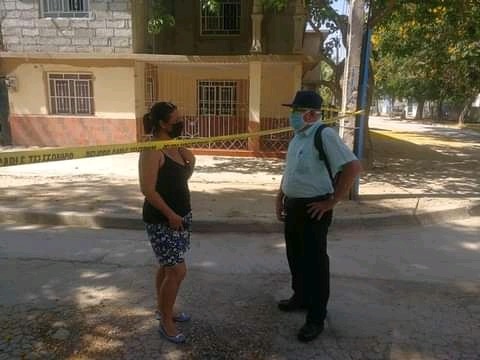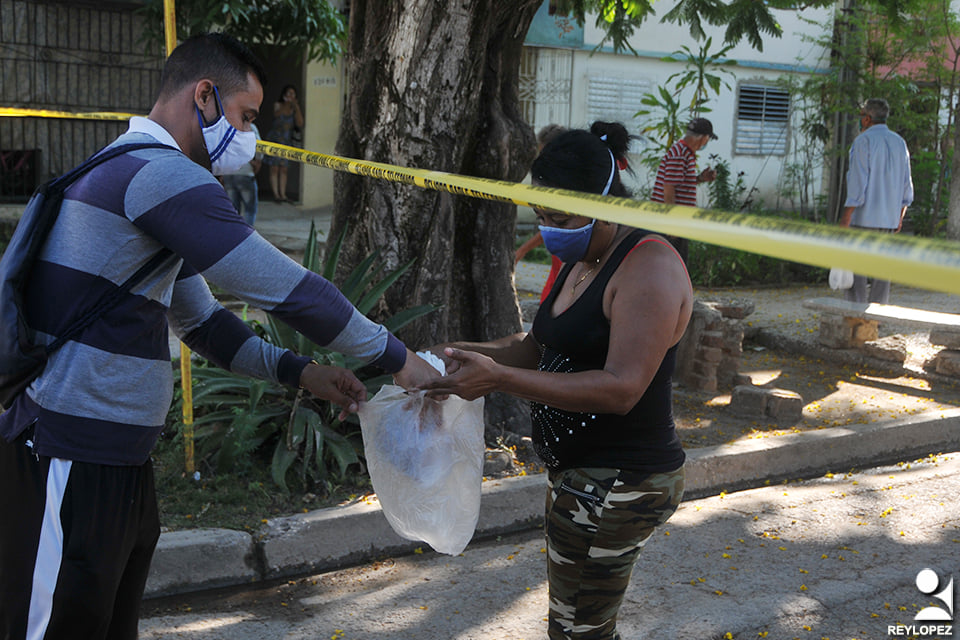
Behind the yellow tape, which restricted the movement of residents in buildings 12 and 13 of the Santos neighborhood, stories were born in the heat of fear and uncertainty; and also gestures of solidarity in days of inescapable confinement. From the balconies, affections and encouraging phrases were spread with the typical joviality of our people.
"It has not been easy," Luisa Elena Rivera, one of the inhabitants of the place, confesses with still warm emotions. Almost a week ago, the diagnosis of positive neighbors for COVID-19 changed the routines of everyone there, and more than that, fear crept under the doors, and then yes, the disease became a reality that was too close.
She tells me that she got home around 7:30 pm on Tuesday after a strenuous workday. Someone intercepted her at the entrance to the stairs to give her the news that kept her on edge for much of the night.
The next day, she woke up earlier than usual and in the middle of a strange silence the tension was breathed, but that was only the beginning. They saw the health personnel arrive, wearing green suits, masks, gloves, a vision that was not alien to them, but never so close. They were called one by one to take the PCR sample without neglecting the sanitary protocols.
Later, a yellow cord would leave them isolated, with a few concerns that, although shared weighed a little less, they still had a “bitter taste”.
“When I saw that the block was closed, my chest tightened and I even wanted to cry. That was the confirmation that we would be in quarantine without being able to leave. After that impact, we had to face our situation.”
IN RED ZONE

At that time, the world came over Evaristo Guerra Peña. For him, who at 72 years of age never ceases to amaze by his vitality, that confinement was real torture. Looking at those who were bringing supplies on the other side of the tape, and not being able to do anything, made him feel caged.
For Antonio Espinosa Cutiño, 80, it was no less complicated. He likes to go out in the mornings, go to buy bread, sit down to talk in the basement of the building, and visit his son who lives nearby. He had to be content with listening to the voices “jumping” from one side to the other, and responding to greetings from the distance.
Very close to her, Luz Virgen Suárez also faced her own challenges. She is in charge of her great-grandson, a vivacious 7-year-old boy, as her granddaughter is on a mission in Venezuela. She had to manage to keep him entertained within "four walls", but both adapted well and followed the directions with discipline.
The youngest, like Andy Daniel, found a way out of isolation through social media, but he says that he experienced firsthand the fear of being infected with the virus. "We know that it is a disease that can cause us death and we have never experienced something similar."
Despite the distance, these neighbors on Agustín Cebereco Street, in the populous distribution, were very close. Perhaps because of that "congenital" solidarity of the Las Tunas people, there was no lack of support; and that confinement did not translate, not even remotely, into abandonment.
From the first moment, the delegate Alexis Ochoa proposed to the residents to select a person responsible for looking for the essential products, marketed by the supply book. Then responses were given to other needs, according to individualities.
Workers of the Sports sector brought the supplies to the point that indicated the risk zone. They did not know to whom that food was; but they extended their hands with the certainty that they were doing good, an altruistic work that also deserves recognition. "We did not feel alone at any time and, even, they brought us bread, breadsticks, pancakes, ice cream, soft drink, syrup, meats, vegetables, spices ...," Luisa Rivero thanks.
She also recognizes the tireless work of the health personnel. Every morning they began the journey from house to house and inquired about the health of the inhabitants, always well protected. In that coming and going they gave words of encouragement and timely advice so that everyone, from their site, could build a real trench against the coronavirus.
FOR THE YELLOW TAPES TO DISAPPEAR
 For some time now, many people from Las Tunas have been confined behind that dividing line that tries to mark those places where the SARS-CoV-2 virus has crept into. The rise in positive cases marks the worst scenario experienced by this region since the disease appeared in the national territory, in March 2020.
For some time now, many people from Las Tunas have been confined behind that dividing line that tries to mark those places where the SARS-CoV-2 virus has crept into. The rise in positive cases marks the worst scenario experienced by this region since the disease appeared in the national territory, in March 2020.
The danger of a transmission spreads throughout the province without it reaching to cut off the indiscipline of those who misuse the facemask and disrespect the necessary physical distancing. Measures taken by government authorities are not enough if there is no individual conscience; "Think about what I can do to avoid the disease, without focusing so much on the next person." This is how the epidemiologist Diamela Moreno Varela recently referred.
Although a single confirmed patient has to be cause for concern, it is clear that the increase in the numbers of the current month sets off the alarms. In the first 17 days, 151 cases were diagnosed, a figure higher than those of January, February, and even the same period of March, the worst month of the pandemic here.
The circulation of the South African variant in this locality poses greater challenges due to its high transmissibility. And the statistics already show the effects in this part of the Cuban geography with the rise of the confirmed and the report of a new deceased.
Currently, 40 outbreaks are kept under surveillance; 29 of them are in the provincial capital, two in the municipality of Manatí, one in Puerto Padre, five in Jobabo, two in "Colombia" and one in "Amancio". Cutting the rebound of the disease will not depend on good luck but the responsible attitude of each citizen.
***
The resistance to remain isolated that some residents of Agustín Cebereco Street showed at first, dissipated before reasons; the young man on the fourth floor understood that the best thing for his wife, admitted to a Maternity Home, and for her entire family, was to abide by the measure; Old Antonio weighed the risks and began looking for reasons within his walls. Evaristo, on his side, used his time to admire the gesture of those boys, and he felt well served.
Luisa ended up doing what she likes the most: informing people. The confinement did not prevent her from doing her job thanks to new technologies, and the audience of Radio Victoria invariably listened to her reports.
Everyone there found a way to escape the lonely hours and, from the balconies, they shared anecdotes and also the joy of each negative diagnosis; the same that multiplied when they saw the yellow tape fall.




